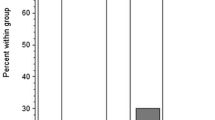Abstract
Sweat function was studied in patients with Parkinson's disease and in normal adults by sympathetic skin response, the bromphenol blue printing method and the silicone mould method. In patients with Parkinson's disease, dysfunction of sweating was classified into two types: one type involved the postganglionic fibres and the other involved the preganglionic fibres or the central nervous system. The latter was observed in patients with milder disease and the former was observed in patients with severe disease. The progressive involvement of sweat function in Parkinson's disease may reflect spread from the central nervous system or preganglionic fibres to postganglionic fibres. In a few patients the results of sweat tests were normal. Ceruletide increased sweating in Parkinson's disease patients, and decreased the prolonged latency of the sympathetic skin response. It is hypothesized that ceruletide facilitates the preserved somatosympathetic reflex of sweating.
Similar content being viewed by others
References
Ahmed ME, Le Quesne PM (1986) Quantitative sweat test in diabetics with neuropathic foot lesions. J Neurol Neurosurg Psychiatry 49:1059–1062
Aminoff MJ, Wilcox CS (1971) Assessment of autonomic function in patients with a Parkinsonian syndrome. BMJ 4:80–84
Appenzeller O, Goss JE (1971) Autonomic deficits in Parkinsons syndrome. Arch Neurol 24:50–57
Fagius J, Wallin BG (1980) Sympathetic reflex latencies and conduction velocities in normal man. J Neurol Sci 47:433–448
Fagius J, Wallin BG (1980) Sympathetic reflex latencies and conduction velocities in patients with polyneuropathy. J Neurol Sci 47:449–461
Geotz CG, Lutge W, Tamper CM (1986) Autonomic dysfunction in Parkinson's disease. Neurology 36:73–75
Gowers WR (1988) A manual of the diseases of the nervous system. Blakiston, Philadelphia
Hashimoto T, Yanagisawa N (1990) Acute reduction and long-term improvement of chorea with ceruletide (cholecystokinin analogue). J Neurol Sci 100:178–185
Heinz-Erian P, Dey RD, Flux M, Said SI (1985) Deficient vasoactive intestinal peptide innervation in sweat glands of cystic fibrosis patients. Science 229:1407–1408
Heinz-Erian P, Paul S, Said SI (1986) Receptors for vasoactive intestinal peptide on isolated human sweet glands. Peptide 7 [Suppl 1]:151–154
Herrman F, Prose PH, Sulzberger MB (1951) Studies on sweating; a new quantitative method of assaying sweat delivery to circumscribed areas of skin surface. J Invest Dermatol 27:241–245
Hoehn MM, Yahr MD (1967) Parkinsonism: onset, progression and mortality. Neurology 17:427–442
Kennedy WR, Sakuta M, Sutherland D, Goety F (1984) Quantitative of the sweating deficiency in diabetes mellitus. Ann Neurol 15:482–488
Knezevic W, Bajada S (1985) Peripheral autonomic surface potential. A quantitative technique for recording sympathetic conduction in man. J Neurol Sci 67:239–251
Langston JW, Forno LS (1978) Hypothalamus in Parkinson's disease. Ann Neurol 3:129–133
Mano Y (1988) Sympathetic skin response and autonomic nervous system. Clin EEG (Osaka) 36:71–75
Mitsuma T, Adachi K, Hirooka Y, Yuasa K, Ishikawa A, Kimura M (1990) Effect of ceruletide administration on somatostatin, VIP and TRH concentrations in rat brain. Annual Report of the Research Committee of Neuropeptide. The Ministry of Health and Welfare of Japan, Tokyo p 284–287
Niakan E, Harati Y (1988) Sympathetic skin response in diabetic peripheral neuropathy. Muscle Nerve 11:261–264
Nishikawa T, Tanaka M, Tsuda A, Kuwahara H, Koga I, Uchida Y (1986) Effect of ceruletide on tardive dyskinesia: a pilot study of quantitative computer analyses on electromyogram and mirco vibration. Psychopharmacology 90:5–8
Quinton PM (1983) Sweating and its disorders. Annu Rev Med 34:429–452
Sakurai M, Montagna W (1965) Observation on the eccrine sweat glands of Lemur Mongoz after denervation. J Invest Dermatol 44:87–92
Sandroni P, Ahlskog JE, Fealey RD, Low PA (1991) Autonomic involvement in extrapyramidal and cerebellar disorders. Clin Anton Res 1:147–155
Sato A, Schmidt RF (1973) Somatosympathetic reflexes: afferent fibers, central pathways, discharge characteristics. Physiol Rev 53:916–947
Shahani BT, Halperin JJ, Boulu P, Cohen J (1984) Sympathetic skin response — a method of assessing unmyelinated axon dysfunction in peripheral neuropathies. J Neurol Neurosurg Psychiatry 4:536–542
Snedecor GW, Cochran WG (1967) Statistical methods, 6th edn. Iowa State University Press, Iowa
Sobue I, Murakami K, Sobue G, Kumazawa K, Mitsuma T, Yasuda T (1988) Effects of ceruletide and LHRH on human sudomotor function. Annual Report of the Research Committee of Neuropeptide. The Ministry of Health and Welfare of Japan, Tokyo, p 277–281
Turkka JT, Myllylä VV (1987) Sweating dysfunction in Parkinson's disease. Eur Neurol 26:1–7
Yokota T, Matsunaga T, Okiyama R, Hirose K, Tanabe H, Furukawa T, Tsukagoshi H (1991) Sympathetic skin response in patients with multiple sclerosis compared with patients with spinal cord transection and normal controls. Brain 114:1381–1394
Author information
Authors and Affiliations
Rights and permissions
About this article
Cite this article
Mano, Y., Nakamuro, T., Takayanagi, T. et al. Sweat function in Parkinson's disease. J Neurol 241, 573–576 (1994). https://doi.org/10.1007/BF00920619
Received:
Revised:
Accepted:
Issue Date:
DOI: https://doi.org/10.1007/BF00920619




